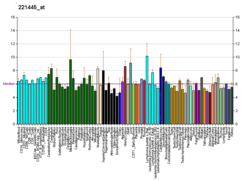OR1A2
Olfactory receptor 1A2 is a protein that in humans is encoded by the OR1A2 gene.[3][4]
| OR1A2 | |||||||||||||||||||||||||
|---|---|---|---|---|---|---|---|---|---|---|---|---|---|---|---|---|---|---|---|---|---|---|---|---|---|
| Identifiers | |||||||||||||||||||||||||
| Aliases | OR1A2, OR17-6, olfactory receptor family 1 subfamily A member 2 | ||||||||||||||||||||||||
| External IDs | OMIM: 618047 GeneCards: OR1A2 | ||||||||||||||||||||||||
| |||||||||||||||||||||||||
| |||||||||||||||||||||||||
| Orthologs | |||||||||||||||||||||||||
| Species | Human | Mouse | |||||||||||||||||||||||
| Entrez |
| ||||||||||||||||||||||||
| Ensembl |
| ||||||||||||||||||||||||
| UniProt |
| ||||||||||||||||||||||||
| RefSeq (mRNA) |
| ||||||||||||||||||||||||
| RefSeq (protein) |
| ||||||||||||||||||||||||
| Location (UCSC) | Chr 17: 3.2 – 3.2 Mb | n/a | |||||||||||||||||||||||
| PubMed search | [2] | n/a | |||||||||||||||||||||||
| Wikidata | |||||||||||||||||||||||||
| |||||||||||||||||||||||||
Olfactory receptors interact with odorant molecules in the nose, to initiate a neuronal response that triggers the perception of a smell. The olfactory receptor proteins are members of a large family of G-protein-coupled receptors (GPCR) arising from single coding-exon genes. Olfactory receptors share a 7-transmembrane domain structure with many neurotransmitter and hormone receptors and are responsible for the recognition and G protein-mediated transduction of odorant signals. The olfactory receptor gene family is the largest in the genome. The nomenclature assigned to the olfactory receptor genes and proteins for this organism is independent of other organisms.[4]
Ligands
The known ligands of OR1A2 are near-identical to those of OR1A1.[5] Examples of known ligands, most of which have citrus or fruity smells:[5][6]
- (S)-(−)-citronellal
- Helional
- Heptanal
- Octanal
- Nonanal (weaker than heptanal/octanal[5])
- Hydroxycitronellal
- Citral
- (S)-(−)-Citronellol (in contrast to OR1A1 only this enantiomer is effective; weaker than citronellal[5])
See also
Notes
- GRCh38: Ensembl release 89: ENSG00000172150 - Ensembl, May 2017
- "Human PubMed Reference:". National Center for Biotechnology Information, U.S. National Library of Medicine.
- Glusman G, Sosinsky A, Ben-Asher E, Avidan N, Sonkin D, Bahar A, Rosenthal A, Clifton S, Roe B, Ferraz C, Demaille J, Lancet D (Apr 2000). "Sequence, structure, and evolution of a complete human olfactory receptor gene cluster". Genomics. 63 (2): 227–45. doi:10.1006/geno.1999.6030. PMID 10673334.
- "Entrez Gene: OR1A2 olfactory receptor, family 1, subfamily A, member 2".
- Schmiedeberg, K., Shirokova, E., Weber, H.-P., Schilling, B., Meyerhof, W., & Krautwurst, D. (2007). "Structural determinants of odorant recognition by the human olfactory receptors OR1A1 and OR1A2". Journal of Structural Biology. 159 (3): 400–412. doi:10.1016/j.jsb.2007.04.013.CS1 maint: uses authors parameter (link)
- Audouze K, Tromelin A, Le Bon AM, Belloir C, Petersen RK, Kristiansen K, et al. (2014). "Identification of odorant-receptor interactions by global mapping of the human odorome". PLOS ONE. 9 (4): e93037. Bibcode:2014PLoSO...993037A. doi:10.1371/journal.pone.0093037. PMC 3973694. PMID 24695519.
References
- This article incorporates text from the United States National Library of Medicine, which is in the public domain.
Further reading
- Fuchs T, Malecova B, Linhart C, et al. (2003). "DEFOG: a practical scheme for deciphering families of genes". Genomics. 80 (3): 295–302. doi:10.1006/geno.2002.6830. PMID 12213199.
- Strausberg RL, Feingold EA, Grouse LH, et al. (2003). "Generation and initial analysis of more than 15,000 full-length human and mouse cDNA sequences". Proc. Natl. Acad. Sci. U.S.A. 99 (26): 16899–903. Bibcode:2002PNAS...9916899M. doi:10.1073/pnas.242603899. PMC 139241. PMID 12477932.
- Malnic B, Godfrey PA, Buck LB (2004). "The human olfactory receptor gene family". Proc. Natl. Acad. Sci. U.S.A. 101 (8): 2584–9. Bibcode:2004PNAS..101.2584M. doi:10.1073/pnas.0307882100. PMC 356993. PMID 14983052.
- Gerhard DS, Wagner L, Feingold EA, et al. (2004). "The Status, Quality, and Expansion of the NIH Full-Length cDNA Project: The Mammalian Gene Collection (MGC)". Genome Res. 14 (10B): 2121–7. doi:10.1101/gr.2596504. PMC 528928. PMID 15489334.
External links
- OR1A2+protein,+human at the US National Library of Medicine Medical Subject Headings (MeSH)


